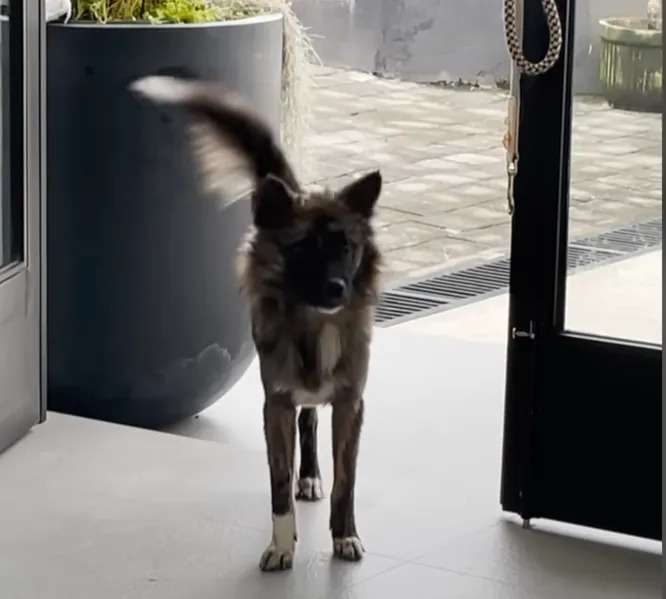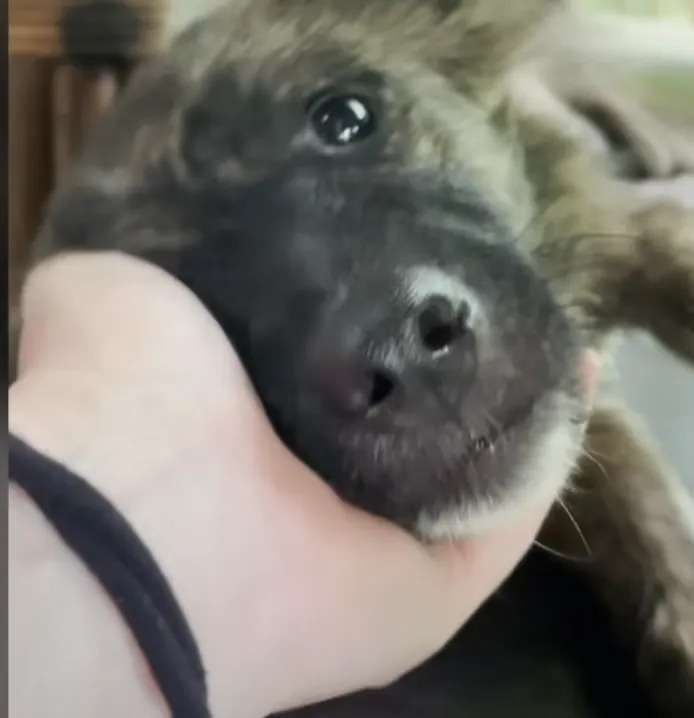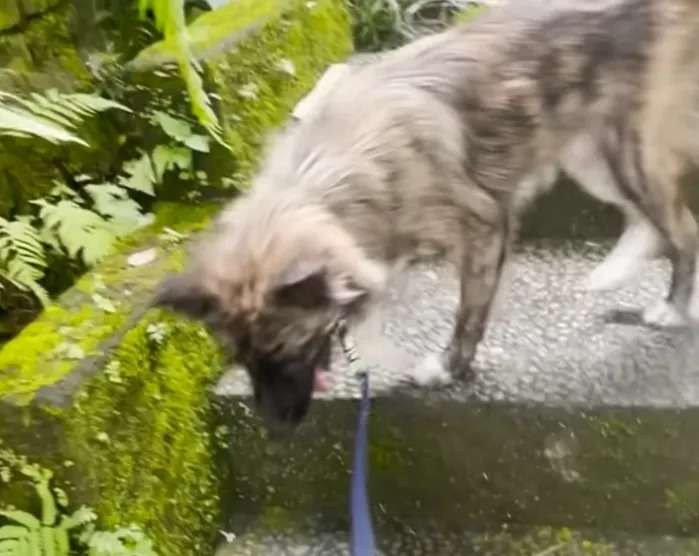Jake was a shadow, a fleeting glimpse of brown fur darting through the alleys, forever just out of reach. A seasoned rescuer, familiar with the skittish nature of strays, knew this wouldn’t be an easy capture. Jake’s fear of humans was palpable, his wary eyes constantly scanning for danger. Days turned into weeks, each attempt to approach ending in a frantic retreat. Frustration gnawed at the rescuer, the desire to help this wary soul battling against the limitations of caution.

Then, a glimmer of hope emerged in the form of Murphy, a friendly, outgoing resident at the rescue. Murphy, unfazed by Jake’s initial apprehension, became a bridge of trust. The rescuer began bringing Murphy along on his visits, a silent ambassador radiating warmth and safety. Slowly, a shift occurred. Jake’s skittishness around Murphy lessened, replaced by a tentative curiosity. He would cautiously approach, sniffing the air, his tail hesitantly wagging.

With each passing day, the bond between them solidified. Murphy’s unwavering friendliness chipped away at Jake’s fear, paving the way for a cautious acceptance of the rescuer. Days turned into weeks, and the once impossible feat began to seem attainable. One crisp morning, as the rescuer knelt by the familiar alleyway, a miracle unfolded. Jake, with a tentative wag and a lowered head, walked right through the open door.

Relief washed over the rescuer as he gently secured Jake, his heart swelling with the joy of a hard-won victory. Careful examination revealed a matted coat and a hint of undernourishment, the marks of a life lived on the fringes. But Jake’s eyes, once filled with fear, now held a spark of hope.

Weeks of care and rehabilitation followed. Jake thrived in the haven of the rescue, his playful spirit blossoming under the watchful eyes of his caregivers. He revelled in the simple pleasures – a warm bed, a full belly, and the companionship of other dogs.

Finding a permanent home for a stray with such a past was a daunting task. Yet, the rescuer knew that Jake deserved a chance at a life filled with love and security. Through the network of dedicated rescuers, a perfect match was found. A kind couple, seeking a furry companion, opened their hearts and home to Jake.

Saying goodbye was bittersweet. The joy of knowing Jake had found his forever family was tempered by the pang of losing a friend. But the memory of that hesitant step through the door, a testament to unwavering trust, remained etched in the rescuer’s heart. It was a reminder that even the most fearful souls can find solace and love and that sometimes, the greatest victories are those earned with patience and a gentle hand.
Watch The Full Video Here:
If your furry friend suddenly loses interest in their favourite meals, it can be concerning. As a seasoned dog trainer, I understand the worry it can bring when your pup refuses to eat. There are various reasons why your dog might be turning up their nose at mealtime, and it’s essential to figure out the underlying cause to help them get back on track.
From minor issues like a change in routine to more serious health concerns, your dog’s lack of appetite could signal different things. As a responsible pet owner, being attuned to your dog’s behavior is crucial in deciphering the reason behind their decreased appetite. In this article, we’ll explore common factors that may contribute to your dog’s disinterest in food, helping you better understand how to support your furry companion during this challenging time.
Understand the Significance
When your furry friend refuses to eat, it’s crucial to recognize the impact this behavior can have on their overall health and well-being. Here’s why understanding why your dog isn’t eating is essential:
1. Health Indicator
A lack of appetite in dogs can serve as an early warning sign of underlying health issues. By paying attention to changes in your dog’s eating habits, you can potentially identify health concerns sooner rather than later.
2. Nutritional Needs
Proper nutrition is vital for your dog’s growth, energy levels, and immune system. When they stop eating, they might not be receiving essential nutrients, leading to deficiencies that can affect their health in the long run.
3. Behavioral Changes
A loss of appetite can sometimes indicate behavioral changes or emotional distress in your dog. Understanding the root cause of their decreased food intake can help address any underlying behavioral issues they may be experiencing.
4. Monitoring Progress
By understanding why your dog is not eating, you can better track their progress once you implement changes or seek veterinary care. Monitoring their eating habits is crucial to ensuring they get back on track to good health.
5. Bond and Communication
Being attentive to your dog’s eating habits fosters a stronger bond between you and your pet. It allows you to communicate effectively with them and address any issues promptly, enhancing your relationship.
6. Prompt Intervention
Understanding the significance of your dog’s eating behavior enables you to intervene promptly. Timely action can help prevent potential health complications and ensure your dog gets the care they need.
Conclusion
Recognizing why your dog is not eating is vital for their health, nutrition, behavior, and your relationship with them. By staying observant and addressing any concerns promptly, you can help your furry companion stay healthy and happy.
Possible Reasons for Loss of Appetite
Here are some common reasons why your dog may not be eating:
- Health Issues: Check for dental problems like tooth decay or gum disease, digestive issues such as an upset stomach or constipation, or illnesses like infections and organ issues.
- Stress or Anxiety: Changes in the environment, routine, or new additions to the family can stress your dog, leading to a loss of appetite.
- Medication Side Effects: Some medications can cause a change in your dog’s eating habits. Consult your vet if you suspect this to be the case.
- Spoiled Food: Your dog may refuse to eat if the food is spoiled or has gone bad. Always check the freshness of the food.
- Recent Vaccinations: After vaccinations, some dogs may experience a temporary loss of appetite. This is usually normal but consult your vet if it persists.
- Behavioral Issues: If your dog is feeling anxious, bored, or depressed, it might affect their eating habits. Provide mental stimulation and ensure they are getting enough exercise.
- Temperature Sensitivity: Extreme temperatures can affect your dog’s appetite. Ensure they have a comfortable environment to eat in.
By understanding these potential reasons for your dog’s loss of appetite, you can take appropriate action to address the issue and ensure your furry friend stays healthy and happy.
Behavioral Causes
When your dog’s appetite suddenly decreases, it might be due to various behavioral issues. Here are some common reasons why your furry friend might not be eating as usual:
- Stress and Anxiety: Just like humans, dogs can also experience stress and anxiety, causing them to lose interest in food. Changes in their environment, routine, or even loud noises can trigger stress.
- Boredom: Dogs, especially those left alone for long periods, can get bored, leading to decreased appetite. Providing mental stimulation and interactive toys can help combat this.
- Attention-Seeking Behavior: Some dogs might refuse to eat as a way to seek attention from their owners. This behavior can be addressed through positive reinforcement training.
- Food Preferences: Your dog might be picky about their food. They may not eat if they don’t like the taste or texture of the food being offered.
- Overfeeding: If your dog is getting too many treats or snacks throughout the day, they might be too full to eat their regular meals.
- Recent Changes: Any recent changes in your dog’s routine, such as a new family member, moving to a new house, or changes in feeding times, can impact their appetite.
Understanding these behavioral causes can help you identify the underlying issue and take appropriate steps to improve your dog’s eating habits. Remember, observing your dog’s behavior and making necessary adjustments can help keep your canine companion happy and healthy.
Tips to Encourage Eating
1. Schedule Regular Meal Times:
Stick to a consistent feeding schedule for your dog. Offer meals at the same time each day to establish a routine that can help stimulate your dog’s appetite.
2. Provide a Quiet Feeding Environment:
Create a calm and peaceful eating space for your dog. Avoid loud noises or distractions that could make your furry friend anxious during meal times.
3. Offer High-Value Treats:
Incorporate small portions of tasty treats during your dog’s mealtimes to make the food more appealing and enjoyable. However, ensure that treats do not replace regular meals.
4. Try Different Food Options:
Experiment with various types of dog food, including wet, dry, or raw options, to find what entices your dog’s taste buds. Consult your vet for recommendations on suitable food choices.
5. Warm Up the Food:
Gently warm your dog’s food before serving it. The enhanced aroma from warm food can attract your dog and make mealtime more enticing.
6. Encourage Exercise:
Engage your dog in regular physical activity to stimulate their appetite. Exercise can boost their overall well-being and encourage a healthy appetite.
7. Monitor Portion Sizes:
Ensure you are feeding your dog the appropriate portion sizes based on their size, age, and activity level. Overfeeding can lead to a loss of interest in food.
8. Consult with a Vet:
If your dog’s appetite issues persist, consult with a veterinarian to rule out any underlying health problems and receive tailored advice on encouraging eating.
By implementing these tips, you can help motivate your dog to eat and maintain their health and happiness.
Conclusion
So, there you have it! Remember, when your furry friend isn’t chowing down like usual, it could be a sign of an underlying issue. From health concerns to stress or just a change in routine, there are various reasons why your dog might be turning up their nose at mealtime. By following the tips shared here, like setting a consistent feeding schedule, creating a calm eating environment, and exploring different food options, you can help your pup get their appetite back on track. Don’t forget to keep an eye on portion sizes, encourage some playtime, and if things don’t improve, it’s always best to reach out to your vet for further guidance. Your dog’s health and happiness are top priority, so keep those tails wagging with some tasty meals!
Frequently Asked Questions
What are common reasons for a dog’s decreased appetite?
Common reasons for a dog’s decreased appetite include health issues, stress, and changes in routine.
What are some behavioral issues that can lead to a dog not eating?
Behavioral issues like stress, boredom, and changes in routine can contribute to a dog’s loss of appetite.
How can I encourage my dog to eat?
You can encourage your dog to eat by scheduling regular meal times, providing a quiet feeding environment, offering high-value treats, trying different food options, warming up the food, promoting exercise, monitoring portion sizes, and seeking advice from a vet if needed.